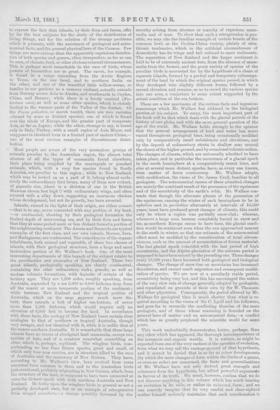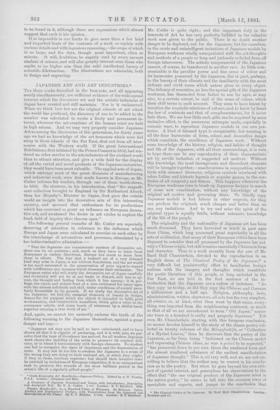MR. A. R. WALLACE'S " ISLA.ND LIFE."
THE mutual relation of apparently far-removed branches of science is every day becoming more manifest, and has been developed ever since Mrs. Somerville wrote her admirable little book on that subject, in a way that is not only interesting, but wonderful, The labourer in narrow fields, the mere collector, even the French naturalist whom some, traveller recently met with in Asia Minor, and whose ignorance of the ornithology and botany of the region astonished the other, until he explained that his life was entirely consecrated " a l'Citude doe Coleopthres," are all contributing to the larger sciences which deal with the history of our planet, and light is now being thrown by beetles and butterflies on the development of vast continents and oceans in far-back ages. Few investigators have done more to unite these opposite spheres of investigation than the distinguished author of the deeply interesting book now before us. Its modest title of Island Life will appear to many at first sight a misnomer, but it has been chosen in order * bland Life ar, the Phetiomena and daueen of Inaular Faunal' and ftol:a8, in- cludira a Mansion and Attempted Solution of the Problem of Geological clanatea. By Alfred Russel Wallace, London Macmillan and Co. 1880. to express the fact that islands, by their flora anti fauna, offer by far the best subjects for the study of the distribution of living things, and for the solution of the strange problems -which it presents, with the assistance of geological and astro- nomical facts, and the general physical laws of the Cosmos. Few things are more .enrione than the apparently capricious distribu- tion of both species and genera, often irrespective, so far as can be seen, of climate, food, or other obvious external circumstances. This is perhaps most remarkable in the case of birds, whose powers of locomotion are so great. The raven, for example, is found in a range extending from the Arctic Regions to Texas, on the one hand, and to northern India on the other, and one of the beautiful little willow-wrens, so funnel, in our gardens as a summer visitant, actually extends from Norway across Asia to Alaska, and southwards to Ceylon, China, and Borneo ; while there is a lovely eunbird (Nee- tarinea ma), as well as some other species, which is strictly limited to the warmer parts of the Valley of the Jordan. Of the Pants paludris, or marsh tomtit, there are two varieties sclassed by some as distinct species), one of which is found over the whole of Europe, and the greater part of temperate Asia, as far as Japan ; while the other, strange to say, is found only in Italy, Turkey, with a small region of Asia Minor, and reappears in identical form in a limited part of eastern China,— one of the most curious examples Of discontinuous distri- bution.
- Most people are aware of the very anomalous groups of animals peculiar to the Australian region, the almost total absence of all the types of xnammalia found elsewhere, their place being supplied by the marsupials or pouched animals, which, with a very few species found in South America, are peculiar to this region ; while to New Zealand, which may be looked on as a part of it, belong almost exclu- sively the extraordinary bird forms, many of them now extinct, of gigantic size, (there is a skeleton of one in the British Museum eleven feet high !) with rudimentary wings, and often covered with a silky down, suggesting an enormous chicken whose development, but not its growth, has been arrested.
Islands, viewed in the light of their origin, are either oceanic —that is to say, never connected. with any portion of dry land, —or conlimenial, showing by their geological formation the limited, depth of intervening sea, and by their flora and fauna that they at some period more or less distant formed a portion of the neighbouring continent. The Azores and Bermuda are typical examples of the first class, and our own islands, Borneo, Java, and Madagascar, are continental. The coincidences of the organic inhabitants, both animal and vegetable, of these two Classes of islands, with .their geological structure, form a large and most instructive portion of Mr. Wallace's book. One of the most interesting departments of this branch of the subject relates to the peculiarities and anomalies of New Zealand. These two great islands, geologically speaking, are clearly continental, containing the older sedimentary rocks, granite, as well as modesn volcanic formations, with deposits of certain of the tertiary ages. They are 1,200 miles, roughly speaking, from Australia, separated. by a sea 2,000 to 3,000 fathoms deep from all the nearer or more temperate portion of the continent ; while between New Zealand and the tropical portion of Australia, which on the map. ppears much more dis- tant, there extends a belt of higher sea-bottom, of never more than 1,000 fathoms, which would require oulY an elevation of 0,000 feet to become dry land. In accordance with these facts, the zoology of New Zealand bears certain close analogies to that of northern or tropical Australia, though very meagre, and not identical with it, while it is unlike that of the nearer southern Australia. It is remarkable that these large islands have no traces of aboriginal laud mammalia, except two species of bats, and of a creature somewhat resembling an otter, which is, perhaps, mythical. The wingless birds, com- prehending no less than fifteen species, great and small, of which only four now survive, are in structure allied to the emu of Australia and the cassowary of New Guinea. They have, according to Mr. Wallace's view, been evolved from some ancestral form common to them and to the Australian birds just mentioned, probably originating in New O tfinea, which, from the structure of the laud, is supposed to have been connected at some far distant epoch with both northern Australia and New Zealand, He looks upon the wingless birds in general as not a partially developed race, but as an example of retrogression from winged ancestors,—a change possibly favoured by the
security arising from absence or scarcity of rapacious maul- media, and of man. To show that such a retrogression is pos- sible, we may cite the familiar example of certain breeds of tle. common fowl, as the Cochin-Chiva, variety, plainly of stru- thiouic tendencies, which in. the artificial circumstances of domesticity has its wings aud tail reduced. to mere rudiments. The separation of New Zealand and the larger continent is held to be of extremely ancient date, from the absence of mam- malia from the former, and the great variety of species of the peculiar birds is accounted for by the hypothesis of a chain of separate islands, formed by a partial and, temporary submergement of the land by which the original species passed, in which they developed into slightly different forms, followed by a second elevation and. reunion, so as to crowd the various species into one area, a conjecture to some extent supported by the actual condition of the sea.bottom.
These are a few specimens of the curious facts and. ingenious reasonings which Mr. Wallace hag adduced in the biological portion of his subject. To many, the most important part of his book will be that which deals with the glacial periods of the history of our globe, and with the more general question of the age of the world. Mr. Wallace holds strongly to the opinion that the general arrangement of land and water has never varied throughout geological time, being occasionally modified. only by comparatively small subsidences and elevations, and. by the deposit of sedimentary strata in shallow seas around the shores of the higher ground, and by occasional volcanic action. The changes of climate, which are universally admitted to have taken place, and in particular the occurrence of a glacial epoch in the north hemisphere at a comparatively recent time, and. also at several more distant epochs, have, as every one knows, been matter of fierce controversy. Mr. Wallace adopts, with modification, the views of Dr. James Croll, familiar to all geologists. The astronomical causes of these admitted, changes are mainly the combined result of the precession of the equinoxes and of the eccentricity of the earth's orbit. Mr. Wallace con- tends that though the alternate phases of the precession of the equinoxes, causing the winter of each hemisphere to be in aphelion and. in perihelion alternately at intervals of 10,500 years,-must have produced great changes of climate, this could. only be where a region was partially snow-clad.; whereas, whenever a large area became completely buried in snow and. ice, as northern Europe seems to have been, the glacial condi- tion would be continued even when the sun approached nearest to the earth in winter, so that our estimate of the astronomical effect must be modified by the consideration of local circum- stances, such as the amount of accumulation of frozen material. The last glacial epoch coincided with. the last period of high eccentricity, and the Alpine glaciation of the mioceue period is supposed to have been caused by the preceding one, These changes. every 10,500 years have hastened both geological and biological changes. The change of snow-line on mountains has increased. denudation, and caused much migration and consequent modifi- cation of species. We are now at a peculiarly stable period., eccentricity being very low, and this has encouraged. the notion of the very slow rate of change generally adopted by geologists, and repudiated on grounds of their own by Sit W. Thomson and other physicists. Consequently, the period allowed by Mr. Wallace for geological time is much shorter than what is re- quired according to the views of Sir C. Lyell and. his followers, and goes far to reconcile the conflicting theories of the mere geologists, and of those whose reasoning is founded on the general laws of matter and on astronomical data,—a conflict which has so greatly perplexed the scientific world for some years.
This work undoubtedly demonstrates, better, perhaps, than any other which has appeared, the thorough interdependence of the inorganic and organic worlds. It is written, as might be expected from one of the very earliest of the apostles of evolution, from what we may call the vantage-ground of that hypothesis, and it cannot be denied that in so far as minor developments (by which the mere changes of form within the limits of a genus, or even an order) are concerned, the facts and generalisations of Mr. Wallace have not only derived great strength and coherence from the hypothesis, but afford powerful argumersts in favour of its truth. We must, however, confess that we do not discover anything in this volume which has much bearing on evolution in its wide, or rather its universal, form ; and. we can scarcely imagine that its very candid, and clear-sighted author himself seriously maiutaitse that such corroboration is
to be found in it, although there are expressions which almost suggest that such is his opinion., It is impossible in our limits to give more than a few brief and imperfect hints of the contents of a work so replete with curious details and with ingenious reasoning,—the scope of which is so large, and the data, though most important, often so minute. It will, doubtless, be eagerly read by every earnest student of science, and will also greatly interest even those who 'aspite to no higher aim than the mild intellectual luxury of ucientific dilettantism. The illustrations are admirable, both in design and engraving.




































 Previous page
Previous page